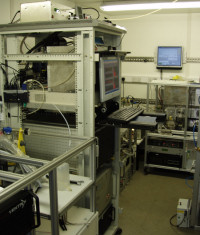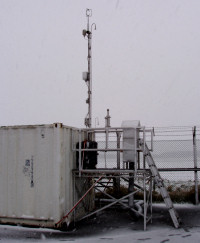APPRAISE-CLOUDS Project - Ground Based Measurements
Introduction
Ground based measurements during the APPRAISE-CLOUDS project consisted of two distinct activities: remote sensing of cloud properties using radar and lidar at the Chilbolton Observatory site; and in-situe aerosol characterisation at the Chilbolton site. The Chilbolton Observatory is located in Hampshire (South West England) close to the town of Andover.
Radar and lidar measurements were made during most of the APPRAISE-CLOUDS flights in the Chilbolton area, with instruments being operated by staff from Chilbolton. Details of the instruments available at the Chilbolton site can be found on the Chilbolton Observatory website.
In-situe aerosol characterisation measurements were made by the Centre for Atmospheric Science during the main flying periods details of these measurements are given below.
In-situe aerosol characterisation at Chilbolton Observatory
The objective of the in-situe aerosol measurements at Chilbolton Observatory was to provide a full and detailed characterisation of the boundary layer aerosol properties, which may under certain meterological conditions be transported up to the level of the clouds being measured by the aircraft. Under these conditions aerosol from the boundary layer may act as either condensation nuclei or ice nuclei upon which cloud particles form. Measurements were made during the following time periods 27/11/08-16/12/08 (1), 5/01/09-15/03/09 (2) and 27/05/09-10/06/09 (3) which covered the majority of the UK based flights. During these time periods some of the instruments on site were operated continuously while others only operated when flights were planned. The table below shows the measurements made during the different time periods of the project.
The Chilbolton Observatory is in a rural location situated just outside the small village of Chilbolton. Under prevailing south westerly winds air sampled at the site was relatively clean and likely to be fairly representative of the regional airmass. With other wind directions and under very slack conditions the site experienced polluted conditions with pollution likely originating from urban areas, roads and in some cases smoke from wood fires used to heat homes in the villages close to the site. If convective conditions developed this polluted air could influence the clouds being sampled by the aircraft. For each flight a close examination of the prevailing meteorological conditions and a comparison of ground based and airborne aerosol measurements gave an indication of the relevance of the ground based measurements to the clouds being sampled.
Most of the instruments deployed at Chilbolton were housed in the CAS sea container laboratory during periods 1 and 2, and in the CAS trailer during period 3. Air was sampled from a height of 5m above the ground close to the edge of the site, away from very local pollution sources. The inlet system was constructed from a 1/2" diameter pipe operated in the turbulent flow regime, with a 4um cut off cyclone to prevent fog particles from being sampled. This inlet arrangement has been used on a number of projects and has been well characterised theoretically and experimentally. Inlet transmission has been found to be close to unity over most of the accumulation mode which was the size range of most interest for this study. Filter samplers and impactors which were intended to sample supermicron aerosol were located on a small platform outside the container and had individual inlets. To provide size distributions of aerosol >4um the GRIMM OPC was installed in a weatherproof box on the inlet mast, this was in addition to a similar instrument which was already installed at the site making long term measurements as part of this project.
| Instrument | Model | Parameter Measured | Data Availability |
|---|---|---|---|
| Sonic anemometer | Gill R3 | 3 dimensional wind speed, temperature, relative humidity, pressure | Continuous 1,2,3 |
| Scanning mobility particle sizer (SMPS) | TSI 3080 and 3010S | Aerosol size distribution (0.012 - 0.5 microns) | Continuous 1,2,3 |
| Condensation particle counter (CPC) | TSI 3025A | Total aerosol number (0.003 - 1 micron) | Continuous 1,2,3 |
| Optical particle counter (OPC) | GRIMM Dust Monitor 1.108 and 1.109 | Aerosol optical diameter (0.3 - 20 microns) | Continuous 1,2,3 + Longterm |
| Aerodynamic Particle Sizer (APS) | TSI 3321 | Aerosol aerodynamic diameter (1-20 microns) | Continuous 1,2 |
| Aerosol Mass Spectrometer (AMS) | Aerodyne C-TOF or H-TOF | Size resolved aerosol chemical composition | Continuous 1,2,3 |
| Cloud condensation nucleus counter (CCN) coupled to differential mobility particle sizer (DMPS) and condensation particle counter | DMT CCN-100, Manchester DMPS1 and |
Aerosol activated fraction as a function of size and supersaturation (0.04 - 0.5 microns) | Continuous 2 |
| Hygroscopic tandem differential mobility analyser (HTDMA) | Manchester | Aerosol hygroscopic growth factors (10-90% RH) as a function of size (0.04 - 0.5 microns) | Continuous 2 |
| Multi-angle absorbtion photometer (MAAP) | Thermo 5012 | Total aerosol optical absorbtion converted to black carbon mass loading (filter technique - multi angle) | Continuous 1,2,3 |
| Photo-acoustic soot spectrometer (PASS) | DMT PASS-3 | Total aerosol optical absorbtion (photo-acoustic technique - 3 wavelengths) | Continuous 1,2 |
| Particulate soot absorbtion photometer (PSAP) | Radiance Research PSAP | Total aerosol optical absorbtion (filter technique - 3 wavelengths) | Semi Continuous 2 |
| Single particle soot photometer (SP2) | DMT SP2 | Single particle black carbon mass and mixing state (laser incandescence technique) | Continuous 2 |
| Wide interest bioaerosol sensor (WIBS) | Uni Hertfordshire WIBS-3 | Bioaerosol size distribution (>0.8 microns) | Continuous 2 |
| Compact cascade impactor (CCI) | Harvard | Collection of particles onto foam substrates for analysis by ion chromatography (6 stages 0.1 - 5 microns) | Long Samples (3-5 days) 2 |
| High volume cascade impactor | Andersen Hivol | Collection of particles onto quartz substrates for analysis for organics (6 stages 0.1 - 10 microns) | Long Samples (3-5 days) part of 2 |
| Filters | Manchester | Collection of particles onto nucleopore substrates for analysis by electron microscopy (2 stages sub and super micron) | Flights only 2 |
| Ice nucleus counter | Manchester | Total number of aerosol which act as ice nuclei (<1.5 microns) | Partial 2 |

Soot Measurements
Soot particles are believed to act as ice nuclei under certain conditions and if incorporated into cloud particles have a significant effect on the radiative properties of the cloud. Thus characterisation of soot particles was one of the objectives of the ground based deployment. As the Centre for Atmospheric Science has a number of soot particle instruments all having different operating principles and all were available for the duration of this project, this project provided an ideal opportunity to intercompare these techniques under a variety of ambient atmospheric conditions. It is hoped that the extensive data set obtained during the project will prove useful for comparing soot measurements made elsewhere with one or other of these instruments.

